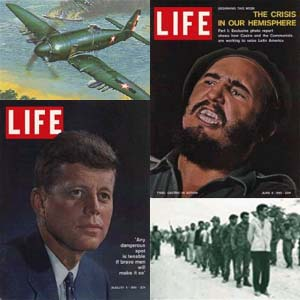
 |
Bay of Pigs invasion |
| HOME |
 |

The Bay of Pigs invasion was an unsuccessful attempt in 1961 to overthrow the government of the Cuban president Fidel Castro by United States-backed Cuban exiles. Increasing friction between the U.S. and Castro's regime led President Dwight D. Eisenhower to break off diplomatic relations with Cuba. The incident quickly became a foreign policy debacle for President Kennedy, who approved the plan just three months into his presidency. This special report provides a historical retrospective of the Bay of Pigs invasion and the events leading up to it. When John Kennedy entered the White House in January of 1961, the training and planning for the exile invasion were nearing completion. The CIA had organized a brigade of about 1,400 exile fighters at a secluded camp in Guatemala, and was infiltrating advance teams of organizers and saboteurs into Cuba. President Kennedy was excited at the prospect of secretly arranging Castro's overthrow, and took an active interest in the planning. When the exile troops landed at the Bay of Pigs in Cuba, the Fidel Castro took personal command of the effort to repel the invaders. He quickly mobilized military and militia units, and instructed his few remaining fighter planes to bomb and strafes the invasion force. Several of Cuba's aircraft had been destroyed in air strikes preceding the invasion. The covert invasion of Cuba had been a foreign policy disaster. The events at the Bay of Pigs resulted in embarrassment for the Kennedy administration and provided Castro with a major issue with which to rally the people of Cuba. Though three and a half decades have passed since the invasion, the memory of the Bay of Pigs continues to influence the present-day tensions between the U.S. and Cuba. |
|
|